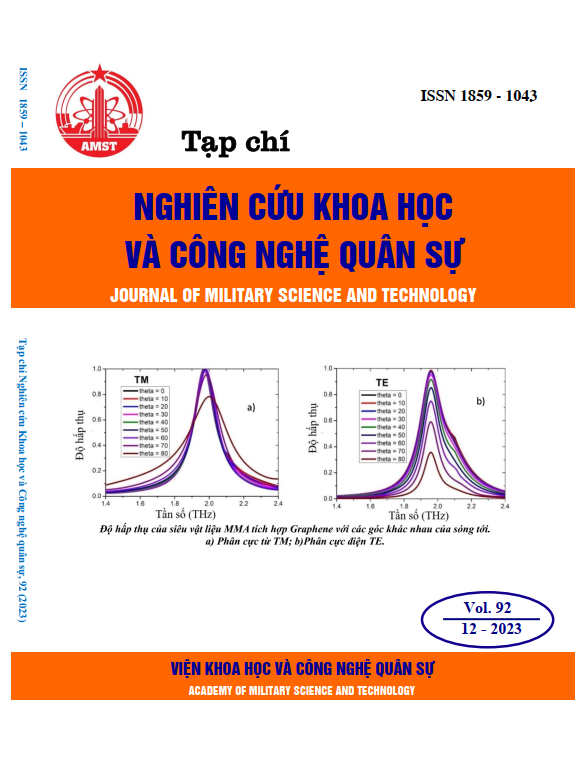Application of spectrum enhance technique for slow flying target detection in radar
292 viewsDOI:
https://doi.org/10.54939/1859-1043.j.mst.92.2023.12-20Keywords:
chirp Z transform, spectrum enhancement, slow flying target, radar, DopplerAbstract
Application of spectrum enhance technique for slow flying target detection in radar
In recent times, with the development of unmanned aerial vehicles capable of operating at low-speed ranges. This causes difficult problems in managing this type of target for older-generation radar systems designed primarily to detect high-speed flying targets. This article proposes a solution to apply a spectral enhancement technique in the near-zero velocity region to detect slow-flying targets by applying the chirp Z transform to enhance the spectrum in the region of interest to increase resolution for low-velocity target detection processing.
References
[1]. R.Xu, H. Zhang, “Study of Low-altitude Slow and Small Target Detections on Radar,”, Proceedings of the 2017 5th International Conference on Machinery, Materials and Computing Technology (ICMMCT 2017), pp.529-523, (2017). Doi: 10.2991/icmmct-17.2017.113 DOI: https://doi.org/10.2991/icmmct-17.2017.113
[2]. X. Chen, J. Guan, Z. Bao, and Y. He, “Detection and extraction of target with micromotion in spiky sea clutter via short-time fractional fourier transform,” IEEE Transactions on Geoscience and Remote Sensing, vol. 52, no. 2, pp. 1002–1018, (2014). DOI: https://doi.org/10.1109/TGRS.2013.2246574
[3]. S. P. Sira, D. Cochran, A. Papandreou-Suppappola et al., “Adaptive waveform design for improved detection of low-RCS targets in heavy sea clutter,” IEEE Journal of Selected Topics in Signal Processing, vol. 1, no. 1, pp. 56–66, (2007). DOI: https://doi.org/10.1109/JSTSP.2007.897048
[4]. Y. Zhang, S. Qian, and T. Thayaparan, “Detection of a manoeuvring air target in strong sea clutter via joint time-frequency representation,” IET Signal Processing, vol. 2, no. 3, pp. 216–222, (2008). DOI: https://doi.org/10.1049/iet-spr:20070047
[5]. P. Suresh, T. Thayaparan, and K. Venkataramaniah, “Fourier-Bessel transform and time-frequency-based approach for detecting manoeuvring air target in sea-clutter,” IET Radar, Sonar & Navigation, vol. 9, no. 5, pp. 481–491, (2015). DOI: https://doi.org/10.1049/iet-rsn.2014.0207
[6]. Z. Zhou, S. Zhigang, and W. Renbiao, “Method for detecting ground moving target with range migration,” in Proceedings of the IET International Radar Conference, pp. 141–141, (2009).
[7]. A. Makur and S. K. Mitra, “Warped discrete-Fourier transform: Theory and applications,” IEEE Transactions on Circuits and Systems I: Fundamental Theory and Applications, vol. 48, no. 9, pp. 1086–1093, (2001). DOI: https://doi.org/10.1109/81.948436
[8]. J. G. Proakis and D. G. Manolakis, “Digital Signal Processing: Principles, Algorithms, and Applications”, 3rd ed. Upper Saddle River, NJ, USA: Prentice-Hall, p. 152 and pp. 482–483, (1996).
[9]. H. Yongping, L. Caixia, T. Xiuli, “The simulation of the Chirp-Z Transform based on MATLAB GUI”, Proceeding of 3rd International Conference on Multimedia Technology (ICMT-13), Atlantis Press, pp. 48-54, (2013). DOI: https://doi.org/10.2991/icmt-13.2013.7
[10]. J. Guo, S. Chang, F. Yang, J. Cai, Q. Liu and T. Long, “Low-slow-small target detection using stepped-frequency signals in a strong folded clutter environment”, IET Radar Sonar Navigat., vol. 15, no. 9, pp. 1030-1044, (2021). DOI: https://doi.org/10.1049/rsn2.12095
[11]. M. A. Richards, “Fundamentals of Radar Signal Processing”, McGraw-Hill, USA, pp:93-97, (2005).







